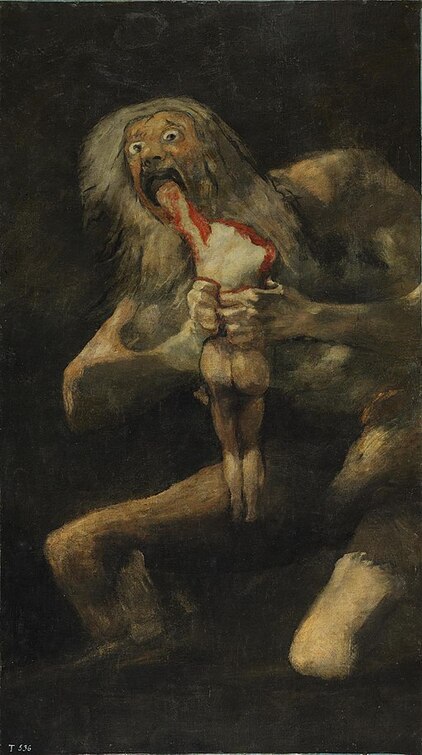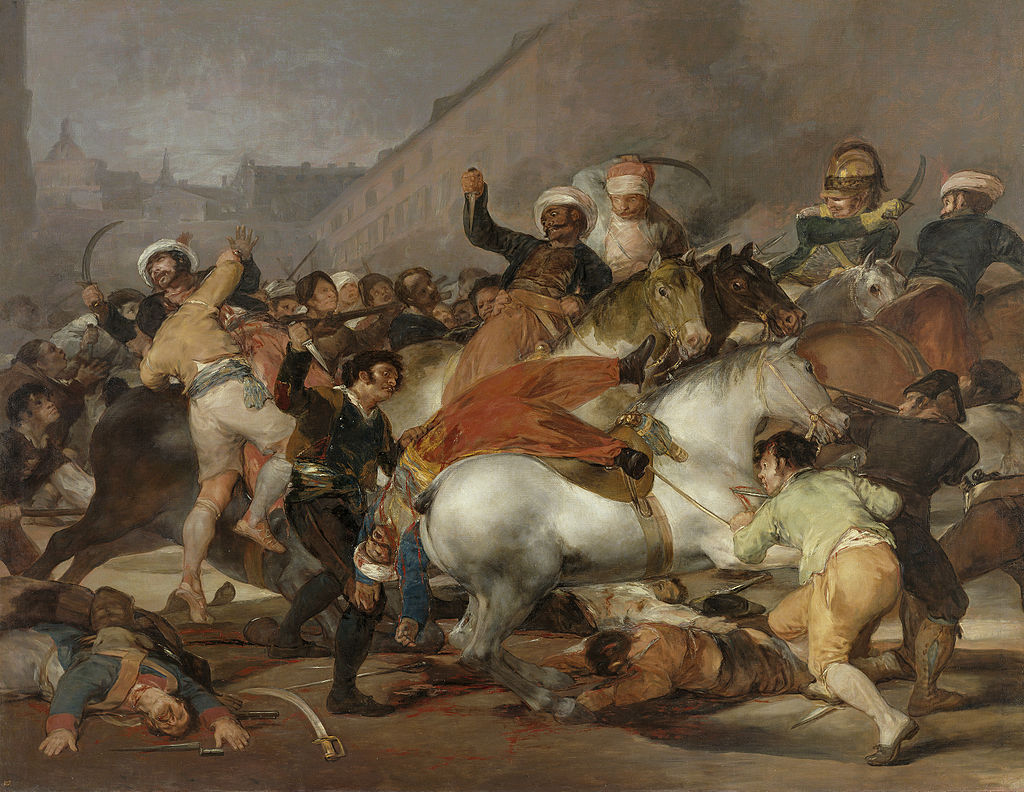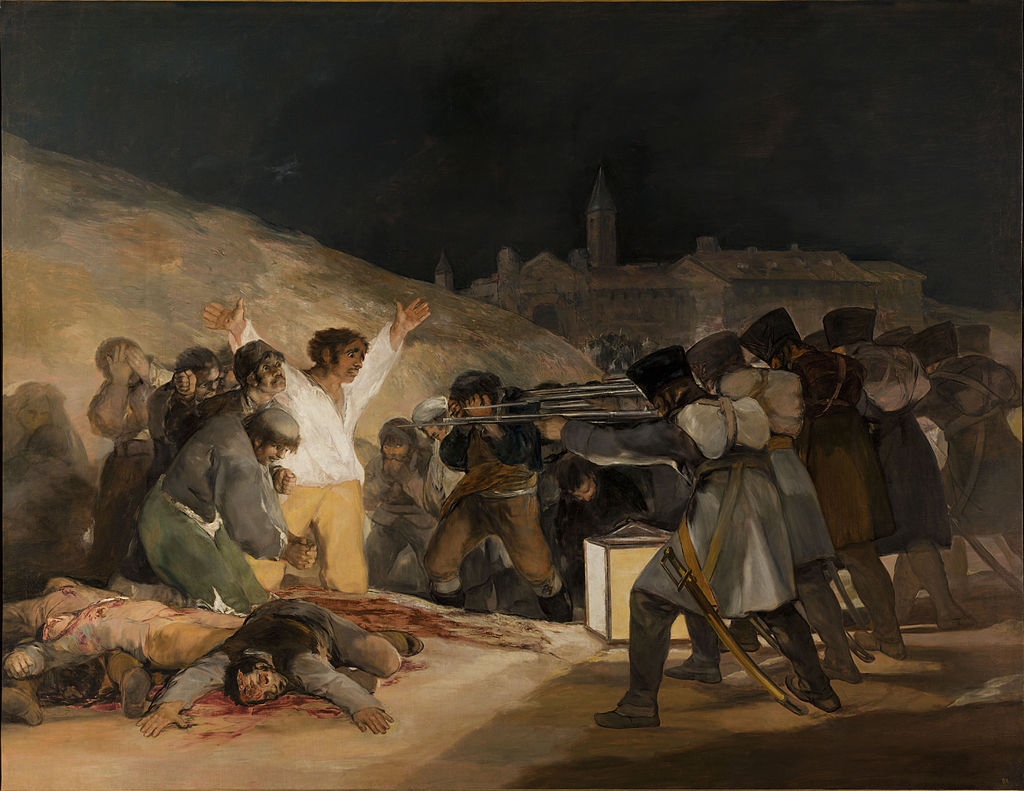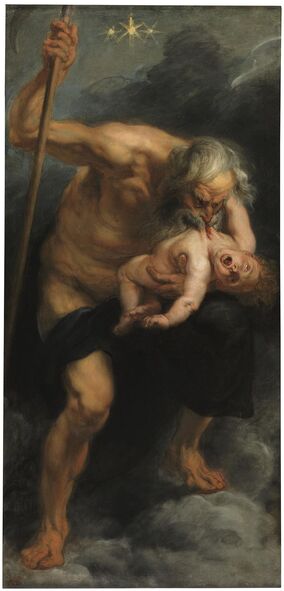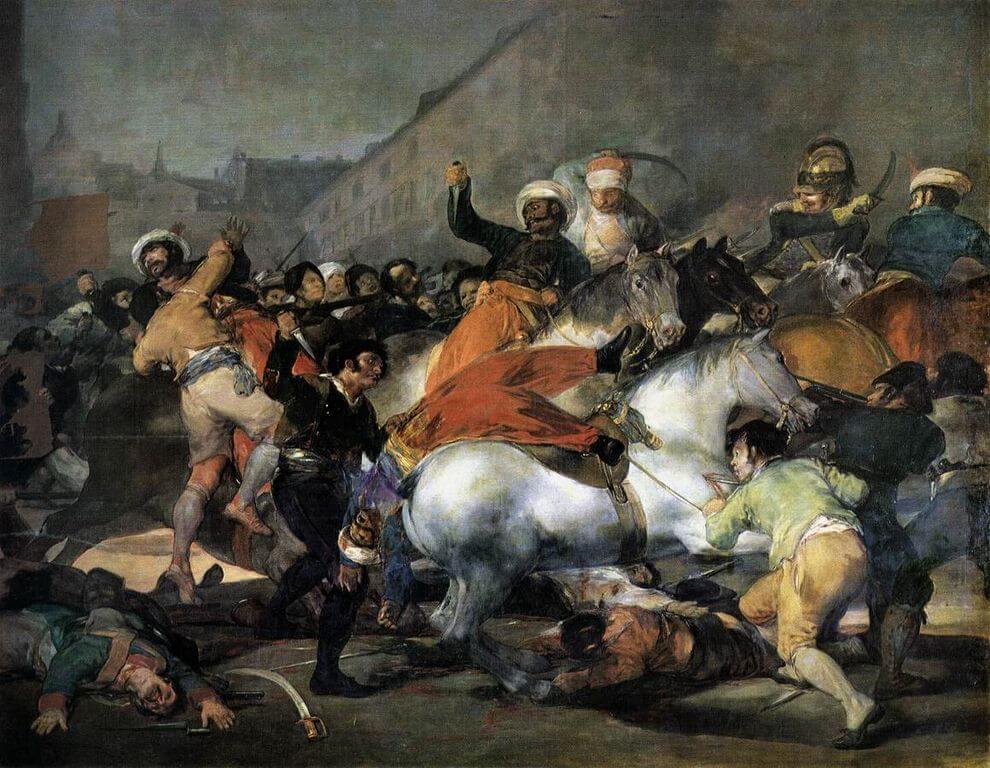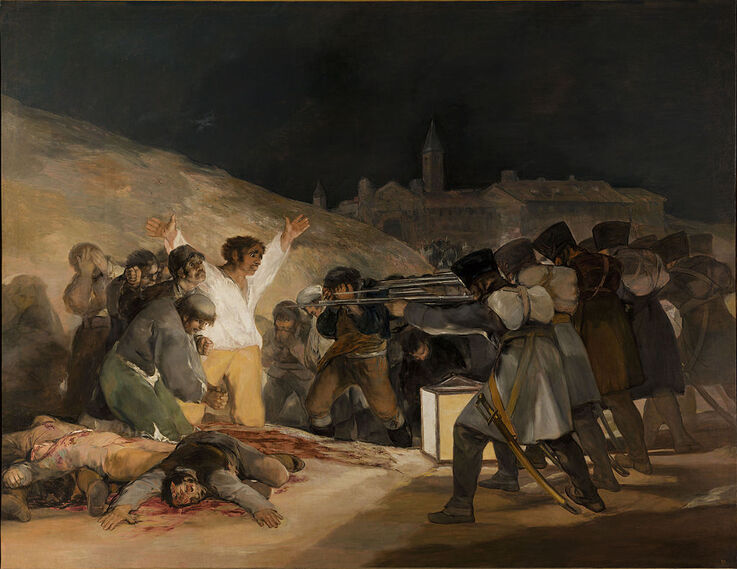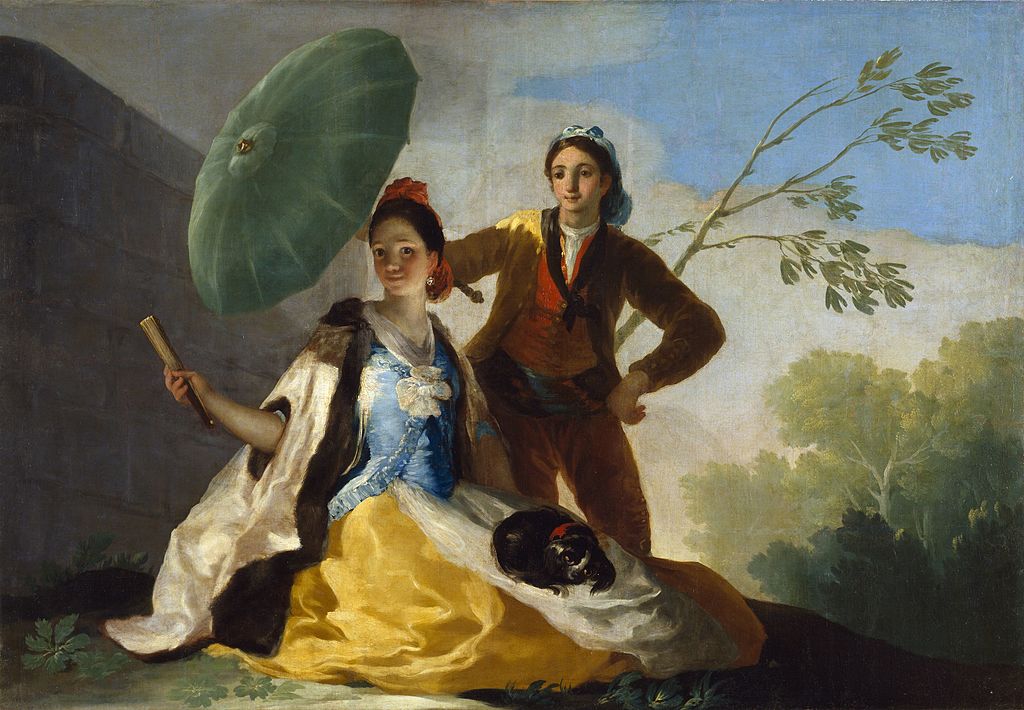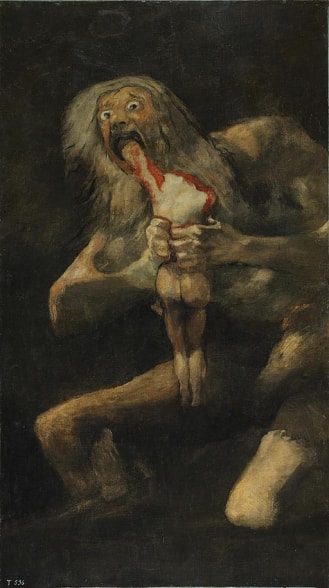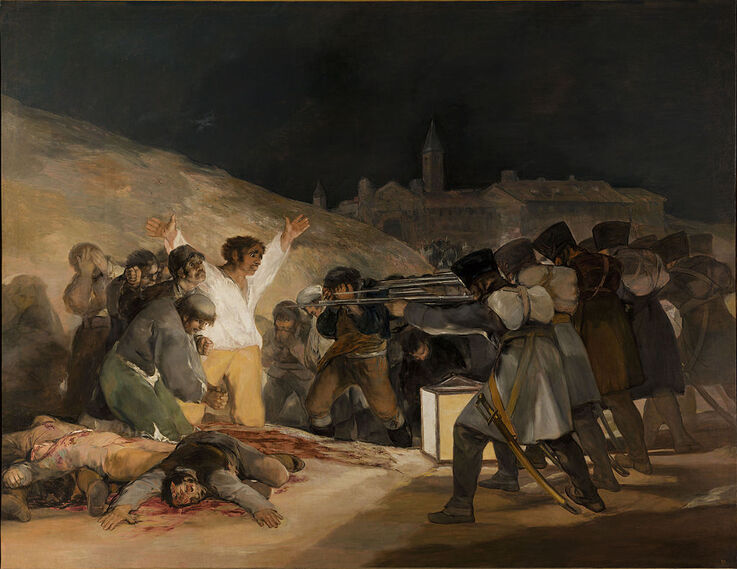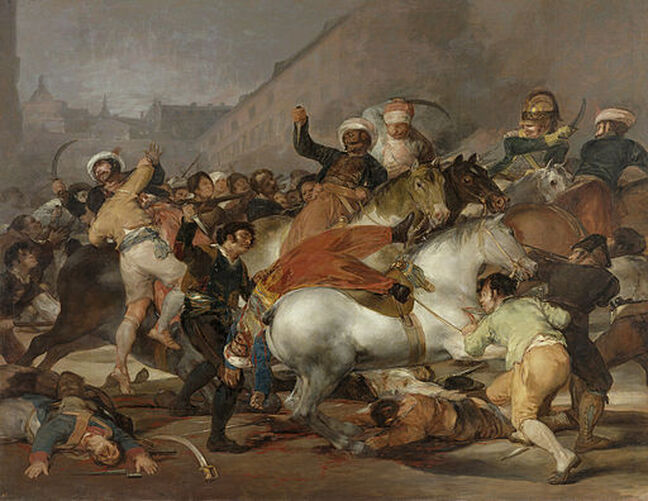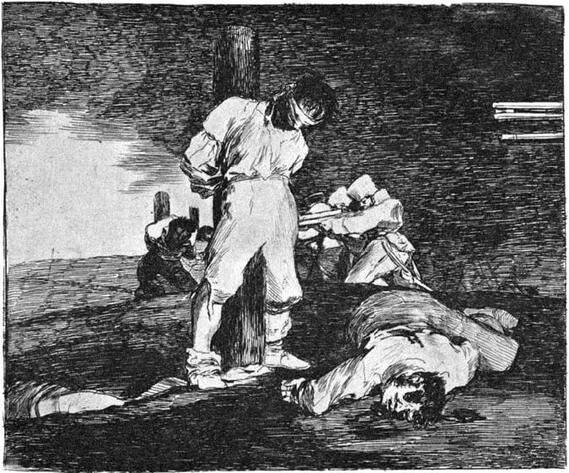|
Where? Room 67 on Floor 0 of the Prado Museum
When? 1820-1823 What do you see? The power-hungry god of time, Saturn, stands in the darkness with the corpse of his son in his hands. His grotesque limbs are abnormally long and twisted. The yellow color of his skin gives him a sickly and monstrous appearance. With a mouth as wide as his eyes, he bites pieces of flesh out of his son’s body. The head and right arm have already been devoured. The corpse hangs limp in his firm hands, fingers digging into the back. Surrounded by muted colors and a black background, the blood flowing out of the son’s body is particularly striking. Slowly, the background seems to obscure Saturn’s body as the shadows slowly swallow his right elbow and thighs. Backstory: In his villa outside of Madrid, Goya created a series of disturbing images which have since been dubbed his Pinturas Negras or Black Paintings. Painted towards the end of his life, these paintings reflected Goya’s pessimistic view towards humanity. The works deal with dark and disturbing themes. One of the most iconic works of this dark series was Saturn Devouring His Son. The painting was created in his dining room, perhaps in response to the Napoleonic Wars which took place towards the end of his life. Witnessing the Spanish government at its worst, Goya was heavily concerned with topics such as abuse of power and violence. Another example of Goya’s black paintings is Witches’ Sabbath which is also on display in the Prado Museum.
The Myth of Saturn: In Greek and Roman mythology, Saturn was the son of Caelus, the god of the sky. When he realized that Caelus’s rule was tyrannical, Saturn overthrew his father and took his place as a supreme leader. Saturn and his wife, Ops, were soon expecting six children. However, it was prophesied that one of these children would overthrow him, granting him a fate not unlike that of Caelus.
In an effort to escape this fate, Saturn devoured five of his children as soon as they were born. Horrified, Ops hid the sixth child, Jupiter, from Saturn and replaced him with a stone wrapped in cloth. Saturn ate the stone and as it passed through his system, it freed the five children that he had swallowed. Later, Jupiter would indeed overthrow his father as a supreme leader and Saturn fled to Latium where he became a god of agriculture. Who is Francisco Goya? Francisco José de Goya y Lucientes was born in 1746 in Fuendetodos in the Northeast of Spain and died in 1828 in Bordeaux, France. He studied drawing and painting in Zaragoza and joined the studio of José Luzán. Later, he studied under Francisco Bayeu Subías who led him to work on decorations for the royal palace. Goya married Subías’s sister and traveled to Italy after failing in two drawing competitions at the Real Academia des Bellas Artes in San Fernando. Eventually, Goya was appointed painter to the Royal Tapestry Factory in Madrid. His work was reminiscent of Rococo art and focused on day-to-day events. As his work gained more attention, Goya rose to the position of court painter to King Charles III and King Charles IV. Around this time, he began to travel Andalusia to study realism. He was commissioned by the Spanish Court to paint some anti-war pieces such as The Second of May 1808 and The Third of May 1808. Goya lived in a villa outside of Madrid called Quinta del Sordo which used to belong to a deaf man. In the later stages of his life, Goya fell ill to an unknown sickness and suffered a hearing loss of his own. Along with his physical health, Goya’s mental health went into decline. Living through major turmoil in Spain, Goya’s outlook on life became very pessimistic and his work became dark and deeply disturbing. The walls of his villa were covered in murals of “Black Paintings’ which have since been transferred onto canvas and moved into the Prado Museum.
Fun fact: Saturn Devouring His Son is believed to have been inspired by Peter Paul Rubens’ Saturn which was painted in the 1630s. Rubens’ depiction of Saturn appears to have more consciousness and awareness of his decision of eating his son. Goya, on the other hand, depicts Saturn as completely lost in chaos and fear, consuming his child as if it were necessary for his survival.
0 Comments
Where? Room 64 of the Prado Museum
When? 1814 Commissioned by: The Spanish government What do you see? A scene of a street fight. Napoleon’s Turkish soldiers, the Mamelukes, ride on horses, arms raised with swords. They are recognizable in their turbans and black uniforms. Some of them wear blue shirts and red pants. On the ground are the outnumbered citizens of Madrid. They are peasants and common people recognizable by the dull rags that they wear. A man that appears to be a Spanish soldier stands on the right side in a black uniform. He points his gun towards one of the Mamelukes. In the foreground, a man stabs a white horse as another man on the left raises his arm to stab its rider. Beneath the horse are two dying rebels. Behind, a peasant tackles a Mameluke, jumping off the ground to attack. The numerous blurred faces in the middle ground add to the chaos of the scene. Although the scene looks like a Spanish triumph, the reality of the story is not so. Backstory: This painting commemorates a true historical event. In this work, Goya shows one of many street fights that broke out on the second of May, 1808, when Spanish citizens rebelled against the French occupation. The Spanish people that rebelled during that day were executed by French firing squads on the next day, and Goya captured that event in a separate painting called The Third of May 1808 which is also in the Prado Museum. The painting of The Second of May 1808 is crammed with the bodies of Mamelukes, Spaniards, and horses that tangle to make for a very chaotic scene. The moment is dramatized with the harsh light on the white horse in the center of the painting and the subtle diagonal drawn from the cadaver (bottom left) to the two soldiers with raised weapons (right of center). The work also uses lighter colors and bright reds that put it in direct opposition to The Third of May 1808, which uses darker tones. Goya puts an emphasis on the sacrifice of the Spanish rebels, showcasing their heroism.
May 2, 1808: This was the day that many citizens of Madrid rebelled against the French occupation. Crowds assembled around the Royal Palace of Madrid to protest the French occupation. The French soldiers opened fire on the crowds, triggering street fights and rebellion in other parts of the city. The French armed forces outnumbered the Spanish citizens. When the conflict had subsided, hundreds of Spanish citizens had died. Many survivors were taken prisoner for execution the next day.
May 3, 1808: The day after the Spanish rebelled against the French army, the rebels were executed by French firing squads. Many surviving Spanish rebels were gathered and shot in several locations in Madrid. Supposedly, most of the executed rebels were peasants, artisans, and beggars. About one hundred deaths by firing squads were reported. Goya captured the events on this day in his painting The Third of May 1808, which is also in the Prado Museum. Who is Goya? Francisco Goya was born in 1746 in Fuendetodos in the Northeast of Spain and died in 1828 in Bordeaux, France. He studied drawing and painting in Zaragoza and joined the studio of José Luzán. Later, he studied under Francisco Bayeu Subías who led him to work on decorations for the royal palace. Goya married Subías’s sister and traveled to Italy after failing in two drawing competitions at the Real Academia des Bellas Artes in San Fernando. Eventually, Goya was appointed painter to the Royal Tapestry Factory in Madrid. His work was reminiscent of Rococo art and focused on day-to-day events. As his work gained more attention, Goya rose to the position of court painter to King Charles III and Charles IV. His style was cheerful and warm and included paintings like The Parasol in the Prado Museum. But around 1793, he fell ill and became deaf. After this, Goya’s work became filled with darkness, ghosts, and monsters. An example of such a dark painting is Saturn Devouring His Son, which is also in the Prado Museum.
Fun fact: During the Spanish Civil War between 1936 and 1939, the collection of the Prado Museum was moved to the League of Nations in Geneva. The truck transporting some of Goya’s works was caught in an accident as it was passing through Girona. The Second of May 1808 and The Third of May 1808 were stored together, and both suffered quite a blow. However, The Second of May 1808 suffered more damage. In the process, the canvas of this painting was damaged. Small pieces of the canvas fell off the left side and were lost on the road. Tear marks and scratches are still visible on the left side of the work despite restoration efforts in 1941, 2007, and 2008.
Where? Room 64 of the Prado Museum
When? 1814 Commissioned by: The Spanish government What do you see? A group of French soldiers on the right point their rifles at a Spanish peasant dressed in white. The French firing squad is about to execute the peasant who stands against a hill with his arms raised like a Christ figure in surrender. At his feet are some of his comrades who have been slaughtered by the firing squad, their blood still running on the dirt. And surrounding them are other people that are next in line to face the firing squad. Some of them cover their eyes as they do not want to witness the gruel scene in front of them. Among the people surrounding the man in white is also a bold-headed monk. He is directly to the left (from our point of view) of the man in the center, and he has his hands clasped in prayer, avoiding the eyes of the soldiers. Backstory: This painting is a commemoration of a true historical event, Napoleon’s French army invading Spain. This painting shows a particular scene that occurred on May 3, 1808, when the French army decided to execute Spanish citizens that rebelled against them. Francisco Goya was deeply affected by this series of events and decided to create this painting to show the injustice of the French army’s actions. Goya has dramatized the moment. The square lantern in the center pours bright light onto the rebels on the left and the man dressed in white. Goya gives him a Christ-like aura with his arms raised in golden light. The man is made into a martyr while the French soldiers are left anonymous and thus soulless. May 2, 1808: This was the day that many citizens of Madrid rebelled against the French occupation. Crowds assembled around the Royal Palace of Madrid protesting French occupation. The French soldiers opened fire on the crowds, triggering street fights and rebellion in other parts of the city. The French armed forces outnumbered the Spanish citizens. Goya captured the events on this day in his painting The Second of May 1808, which is also in the Prado Museum. The painting depicts the Mamelukes (Napoleon’s Turkish soldiers) in a street fight with Spanish rebels. When the conflict had subsided, hundreds of Spanish citizens had died. Many survivors were taken prisoner for execution the next day.
May 3, 1808: The day after the Spanish rebelled against the French army, the rebels were executed by French firing squads. Many surviving Spanish rebels were gathered and shot in several locations in Madrid. Supposedly, most of the executed rebels were peasants, artisans, and beggars. About one hundred deaths by firing squads were reported.
Who is Goya? Francisco Goya was born in 1746 in Fuendetodos in the Northeast of Spain and died in 1828 in Bordeaux, France. He studied drawing and painting in Zaragoza and joined the studio of José Luzán. Later, he studied under Francisco Bayeu Subías who led him to work on decorations for the royal palace. Goya married Subías’s sister and traveled to Italy after failing in two drawing competitions at the Real Academia des Bellas Artes in San Fernando. Eventually, Goya was appointed painter to the Royal Tapestry Factory in Madrid. Goya's work was reminiscent of Rococo art and focused on day-to-day events. As his work gained more attention, Goya rose to the position of court painter to King Charles III and Charles IV. Around this time, he began to travel Andalusia to study realism. When he returned from his trip, he had fallen ill and gone deaf. Before the decline of his health, much of Goya’s work had been cheerful and warm. After losing his hearing, Goya’s work became dark and filled with monsters, darkness, and ghosts. Witches’ Sabbath in the Prado Museum is an example of such a dark work. It is part of his series of fourteen Black Paintings.
Fun fact: Before painting The Third of May 1808, Goya had worked on a series called The Disasters of War. These gruesome prints showed the violence, gore, and fear that comes from war. Without taking a side in the conflict, Goya expressed great anti-war sentiment. The prints were not published until decades later.
|
Categories
All
|
- Home
- Blog
-
Museums
- Alte Pinakothek
- Art Institute of Chicago
- Baltimore Museum of Art
- Barber Institute of Fine Arts
- Bargello
- Barnes Foundation
- British Museum
- Church of Sant’Anastasia
- Cleveland Museum of Art
- Courtauld Institute of Art
- Detroit Institute of Arts
- Frans Hals Museum
- Galleria Borghese
- Gallerie dell'Accademia
- Getty Museum
- Guggenheim
- Hermitage Museum
- Kunsthistorisches Museum
- Kunstmuseum Basel
- Legion of Honor Museum
- Louvre
- Mauritshuis
- Metropolitan Museum of Art
- Musee d’Orsay
- Museum of Fine Arts in Boston
- Museum of Modern Art
- National Gallery in London
- National Gallery of Art
- National Museum in Poznań
- Norton Simon Museum
- Ny Carlsberg Glyptotek
- Palace of Versailles
- Palazzo Pitti
- Palazzo Vecchio
- Petit Palais
- Philadelphia Museum of Art
- Prado
- Pushkin Museum
- Ravenna Art Museum
- Rijksmuseum
- San Diego Museum of Art
- Santa Maria delle Grazie
- St. Peter's Basilica
- Städel Museum
- Statens Museum for Kunst
- Tate Britain
- Tate Modern
- Timken Museum of Art
- Uffizi
- Vatican Museums
- Wallace Collection
-
Artists
- Altdorfer
- Anguissola
- Berlin Painter
- Bosch
- Botticelli
- Boucher
- Bronzino
- Bruegel the Elder
- Brunelleschi
- Cabanel
- Caillebotte
- Canova
- Caravaggio
- Carpeaux
- Cezanne
- Cimabue
- David
- Degas
- Delacroix
- De Maria
- Donatello
- El Greco
- Fontana
- Fra Angelico
- Fragonard
- Gauguin
- Gentileschi
- Gericault
- Gonzalez-Torres
- Goya
- Hals
- Hogarth
- Hokusai
- Ingres
- Leonardo da Vinci
- Lippi, Filippo
- Longhi, Barbara
- Lorrain
- Makovsky
- Manet
- Massys
- Matisse
- Merian
- Michelangelo
- Mochi
- Modigliani
- Monet
- Panini
- Parmigianino
- Perugino
- Picasso
- Pisanello
- Raphael
- Rembrandt
- Renoir
- Reynolds
- Rivera
- Rodin
- Rubens
- Scultori
- Seurat
- Steen
- Tintoretto
- Titian
- Toulouse-Lautrec
- Turner
- Uccello
- Van der Weyden
- Van Dyck
- Van Eyck
- Van Gogh
- Van Hemessen
- Vasari
- Velazquez
- Vermeer
- Veronese
- Vigée Le Brun
-
Locations
- Books
- About Us

